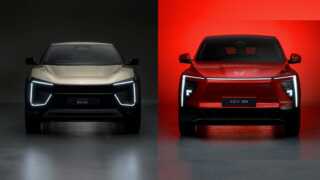“Tier-2s have been a huge revelation for us,” admits Nalinikanth Gollagunta, CEO – Automotive Sector, Mahindra & Mahindra. Markets such as Bhubaneswar, Indore, Jaipur and even Meerut are emerging as unlikely hotbeds of electric mobility. The reasons are as practical as they are compelling: independent homes with dedicated parking, easier access to home charging, shorter daily commutes, and improving highway infrastructure. “A lot of these customers are in the ₹20-lakh-plus bracket, and for them EV adoption has been remarkably seamless,” he adds. The surge in smaller cities is reshaping Mahindra’s playbook. While metros remain important, the company sees Tier-2 demand as a structural tailwind that could accelerate EV penetration beyond today’s modest 5 per cent industry share. For Mahindra, already holding a 41 per cent revenue market share in EVs in Q1, this shift validates its three-tier product strategy of Pack 3 (premium), Pack 2 (mid-range) and Pack 1 (entry). “We began with Pack 3 with both the BE 6 and XEV 9e to establish credentials. Now Pack 2 is entering the market, and Pack 1 will follow, giving us a broader base,” says Gollagunta. Also Read : From 30% to all: How Mahindra’s NU_IQ targets India’s SUV heartland This three-pronged approach is already reflecting in numbers. Monthly EV volumes, which were around 3,500 units earlier, have moved up to 4,000, prompting Mahindra to inch closer to the current limit of 5,000 units monthly. The Pack 2 rollout has clearly expanded the addressable pool of buyers and reinforced the company’s optimism that demand in non-metro markets will be central to the next phase of growth. Product portfolio & premiumisationMahindra’s success in EVs is not happening in isolation. EV play is not a scattershot dash into the future; it is a carefully choreographed climb up the value chain. The idea is to start at the top, create aspiration, and then steadily broaden the base without losing that premium sheen. The Pack 3 models were the opening act, feature-rich, sharply styled and unapologetically premium. They were less about numbers and more about telling buyers: here is an electric Mahindra you can desire, not just consider. Pack 2, now rolling into showrooms, is where the story gets interesting. It trims acquisition costs, but not ambition. The positioning still leans premium, but with an accessibility that speaks directly to the expanding EV curious set, especially in those Tier-2 towns that are rewriting the demand map. And then comes Pack 1, the gateway for first-time EV adopters. It won’t be stripped down for the sake of price. Instead, the promise is simple: make electric mobility attainable without stripping away the Mahindra identity that the earlier packs have worked hard to build. This mirrors Mahindra’s broader SUV strategy. The Scorpio remains the company’s dependable volume driver, but models such as the XUV700 and Thar have brought in younger buyers looking for aspirational mobility. The 3XO, which became the fastest Mahindra SUV to cross the 100,000 mark within a year of launch, underlines how successful the company has been in creating excitement across price points. Variants like the RevX with Dolby Atmos sound systems and plush interiors show that even in the sub- ₹10 lakh bracket, Mahindra is able to inject a touch of premium. Premiumisation, however, is not just about products. It is about nudging customers to higher trims. Gollagunta points out that top-end variants like the AX7 of the XUV700 command a bulk of bookings, suggesting that customers are increasingly willing to pay more for technology and safety. “It shows the shift in customer mindset, value is no longer just about the lowest price,” he said. Challenges and outlookDespite the optimism, challenges abound. The biggest near-term talking point in the industry has been the impact of GST rationalisation on ICE vehicles. With large SUVs now more attractively priced, analysts argue that the price gap between ICE and EVs could shrink, potentially slowing down adoption. Gollagunta, however, dismisses this as a “myth.” He contends that once features, trims, and road tax benefits are factored in, nearly 60 per cent of the EV market is already at price parity with ICE vehicles. “Our approach has never been to sell EVs as a cost story. We design them to excite. If you walk into a showroom and see a Batman edition, you are not thinking about GST arbitrage. You are thinking, I want this vehicle,” he quips. Also Read : From utility to aspiration: How design transformed Mahindra’s SUV identity Supply chain headwinds are another reality. Rare-earth magnet shortages, disruptions in rail logistics and the ever-shifting sands of global battery sourcing are reminders of how fragile supply chains can be. Mahindra has done its bit to de-risk operations, with coverage in place for the next two quarters, but Gollagunta concedes that a few components remain firmly on the watchlist. Then there is regulation, which brings its own set of challenges. With E20 fuel already in play, the company is readying advisories to calm customer anxieties. Owners of newer models can drive without worry, while those with older vehicles may notice a slight dip in performance. Longer term, the conversation shifts to flex-fuel. Here too Mahindra is engaged, working with policymakers to ensure that future pricing frameworks are aligned with energy density rather than raw litre cost, a small but vital detail that could make or break consumer acceptance. Exports, meanwhile, are firmly on the horizon. Built on the “Inglo” (India Global) platform, Mahindra’s EVs are designed from day one for overseas markets. South Africa and Australia are immediate prospects, but the UK is a key focus, with plans to enter in the next 18 to 24 months. “The free trade agreement with the UK is an enabler. Our BEVs will go global in the right time frame,” confirms Gollagunta. Check out Upcoming EV Cars in India. First Published Date: 21 Sept 2025, 11:17 am IST
Source: hindustantimes.com






